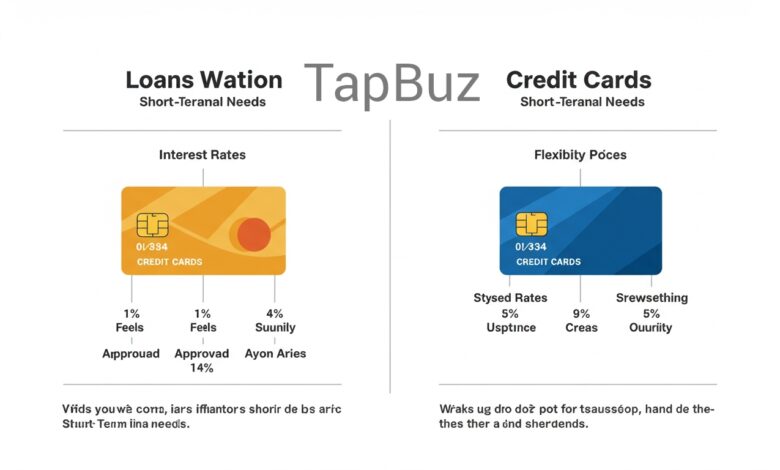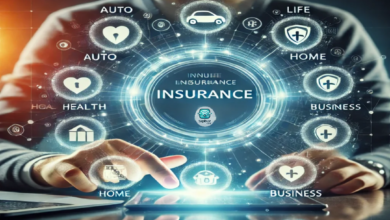Loans Vs. Credit Cards: Which Option Is Better For Your Short-Term Financial Needs? Forpchub.com

When facing short-term financial needs, individuals often find themselves choosing between loans and credit cards. Both options provide access to funds, but they come with different structures, interest rates, repayment terms, and benefits. Choosing the right financial tool depends on factors like the urgency of funds, cost of borrowing, repayment flexibility, and long-term financial impact.
In this article, we will compare loans and credit cards in detail to help you determine the best option for your short-term financial needs.
Understanding Loans
A loan is a financial agreement in which a lender provides a borrower with a lump sum of money that must be repaid over a set period, usually with interest. Loans can be secured (requiring collateral) or unsecured (based on creditworthiness).
Types of Loans for Short-Term Needs
- Personal Loans
- Unsecured loans that can be used for various purposes, such as medical expenses, home repairs, or debt consolidation.
- Fixed interest rates and predictable monthly payments.
- Payday Loans
- Short-term, high-interest loans meant to be repaid by the borrower’s next paycheck.
- Often have extremely high APRs, making them an expensive borrowing option.
- Short-Term Installment Loans
- Typically repaid over a few months to a year.
- Lower interest rates than payday loans but higher than personal loans.
Pros of Loans
✔ Fixed Repayment Terms – Loans come with a clear repayment schedule, making budgeting easier.
✔ Lower Interest Rates – Compared to credit cards, loans usually offer lower interest rates.
✔ Higher Borrowing Limits – Loans allow access to larger amounts, making them ideal for bigger expenses.
Cons of Loans
✖ Longer Approval Process – Applying for a loan requires documentation, credit checks, and processing time.
✖ Potential Fees – Some loans come with origination fees, late payment penalties, and prepayment charges.
✖ Less Flexibility – Once you receive the lump sum, you cannot borrow additional funds without applying for another loan.
Understanding Credit Cards
A credit card provides a revolving line of credit that allows users to make purchases or withdraw cash up to a set limit. Borrowers can carry a balance month to month, but interest is charged on unpaid amounts.
Types of Credit Cards
- Standard Credit Cards
- Provide a set credit limit based on your creditworthiness.
- Interest is charged on balances carried beyond the due date.
- 0% Introductory APR Credit Cards
- Offer zero interest for an initial period (e.g., 12-18 months).
- Useful for short-term borrowing if you can repay before the promotional period ends.
- Rewards Credit Cards
- Offer cashback, travel rewards, or points on purchases.
- Ideal for those who can pay off their balances monthly to avoid interest.
Pros of Credit Cards
✔ Instant Access to Funds – Credit cards provide immediate purchasing power without the need for loan approval.
✔ Flexible Repayment – You can pay the minimum amount, full balance, or anything in between.
✔ Rewards and Perks – Many credit cards offer cashback, travel rewards, and other benefits.
Also Read: TraceLoans.com: A Comprehensive Guide to Loans and Financial Solutions
Cons of Credit Cards
✖ High Interest Rates – If you carry a balance, interest rates can be significantly higher than loans.
✖ Risk of Overspending – Easy access to credit can lead to unmanageable debt.
✖ Impact on Credit Score – High utilization rates and missed payments can harm your credit score.
Comparing Loans and Credit Cards for Short-Term Financial Needs
| Feature | Loans | Credit Cards |
|---|---|---|
| Approval Time | Slower, may take days | Instant or within hours |
| Interest Rates | Lower (especially for secured loans) | Higher, unless using 0% APR offers |
| Repayment Terms | Fixed monthly payments | Flexible, but interest accumulates |
| Best For | Large expenses, planned purchases | Small expenses, immediate needs |
| Risk of Debt | Lower if payments are managed | Higher if balances are carried |
Which Option Is Better for Your Short-Term Financial Needs?
Choose a Loan If:
✔ You need a larger sum of money for a specific expense (e.g., medical bills, home repairs).
✔ You prefer structured repayment with fixed monthly payments.
✔ You want a lower interest rate compared to credit cards.
Choose a Credit Card If:
✔ You need instant access to funds for small or emergency expenses.
✔ You can repay the balance quickly, avoiding high interest.
✔ You want to earn rewards or take advantage of a 0% APR promotional offer.
Case Study Scenarios: Loans vs. Credit Cards
Scenario 1: Emergency Medical Expense ($1,500)
Best Option: Credit Card (if repaid quickly)
- If you can pay off the balance within a month, a credit card is ideal.
- If you need more time, a personal loan with lower interest would be better.
Scenario 2: Home Repairs ($8,000)
Best Option: Personal Loan
- Fixed repayment structure ensures predictable budgeting.
- Interest rates are lower than most credit cards.
Scenario 3: Everyday Expenses ($300-$500 per month)
Best Option: Credit Card (if used responsibly)
- Earn cashback or rewards while covering small, recurring costs.
- Pay the full balance monthly to avoid interest charges.
Final Verdict: Loans vs. Credit Cards
When deciding between a loan and a credit card for short-term financial needs, consider factors such as interest rates, repayment flexibility, borrowing limits, and how quickly you need the funds.
✔ For large, planned expenses – A personal loan is typically the better choice.
✔ For small, urgent expenses – A credit card may be more convenient if repaid on time.
Also Read: MyFastBroker .com: A Comprehensive Guide to Financial Brokerage Services
By understanding the key differences and weighing your personal financial situation, you can make the best choice to manage your short-term financial needs effectively.
For more expert financial tips and advice, visit forpchub.com!



